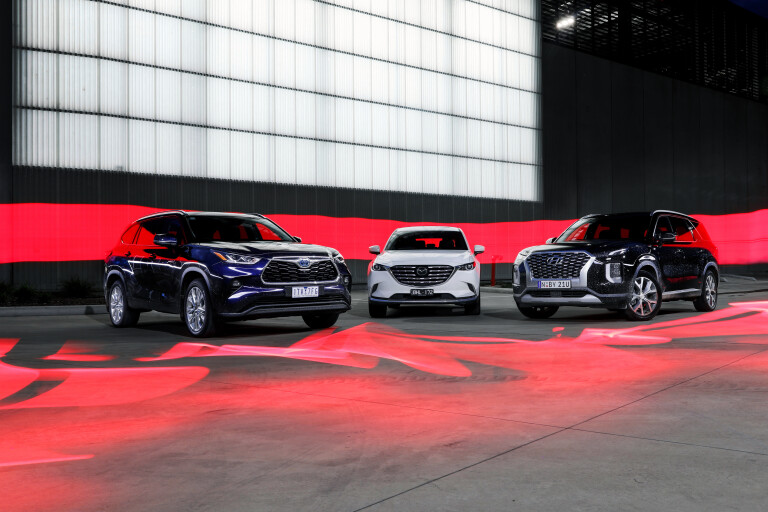
It’s tempting to pour scorn on McMansions, the relatively new phenomenon of enormous, cookie-cutter, brand new homes proliferating profligately in outer suburbs across the nation. They’re easy targets after all.
Architectural fast food, stamped out by the hundreds at our suburban frontiers, they trade subtlety and sophistication for other objectives. Media rooms, double walk-in wardrobes, and butler’s pantries are priority one, and everything else – including elegant design and sympathetic landscaping – is secondary.
But contain thy smugness, for as maligned as they are, these dwellings are also a reflection of what the average Australian wants.
We want as much room and as many features as possible, but we also want value for money. That’s not to say we’re cheapskates – even a modest McMansion is an expensive proposition these days – but we do want to see our dollars go far. There’s nothing wrong with chasing good value.
And the same is absolutely applicable of the cars we buy.
Editor's note: Just days before this story was published online, Hyundai announced MY22 updates to the Palisade. The Palisade Highlander tested here is barely changed, however, with only minor cosmetic differences and no price change.

SUVs might not win beauty contests, but they’re winning sales races. These days the family vehicle of choice tends to have three rows of seats, a big wagon bodystyle and all-wheel drive. There’s also a strong preference for range-toppers – we love a long feature list, and are prepared to pay for it.
With the arrival of a newly-minted Toyota Kluger, long the darling of the family-sized three-row SUV set, it’s a good excuse to examine what life is like in the upper echelons of the mainstream large SUV segment. Joining the fourth-gen Kluger in this test is another fresh-faced arrival, Hyundai’s Palisade, while the COTY-winning Mazda CX-9 is a grizzled veteran that still enjoys strong sales despite its advanced years, and is our benchmark in this segment.
The Kluger nameplate may be vehicular Wonder White, but there’s reason to look in the fourth-generation model’s direction. It’s almost completely new, built atop the largest version of Toyota’s scalable TNGA architecture to date and coming with one sizable ace up its sleeve: a hybrid option.
Aussie appetite for hybrid powertrains has been on a steady rise. At the time of writing, demand in the SUV segment for electrically-assisted crossovers and softroaders was almost double what it was in 2020 – with continued growth expected. That demand is especially pronounced in Toyota-land, with almost three out of every four RAV4 sales in Australia this year being for a hybrid variant and the smaller Yaris Cross notching up a whopping 81 percent hybrid uptake. With an ultra-efficient petrol-electric powerplant available alongside the venerable and familiar 3.5-litre petrol V6, the fourth-gen Kluger appears to have its finger on the pulse of Australian wants and needs.

And so it’s the hybrid that we have here, in top-shelf Grande trim no less. It’s the most expensive Kluger on offer, wearing a $75,400 sticker before on-roads, or $76,075 for the car we’ve got here thanks to a $675 metallic paint charge. Versus a comparatively equipped AWD V6 Kluger, the Hybrid option carries a $2500 premium. We’ll find out shortly if it’s worth it.
At $75,000, the Palisade Highlander seven-seater marginally undercuts the Kluger. It does not have an electrically-assisted engine under its bonnet, rather a 2.2-litre turbo-diesel variant that aligns more closely with the Kluger hybrid on power and price than the available 3.8-litre petrol V6.
For the CX-9, there are no options in the engine bay – it’s either a 170kW 2.5-litre turbo petrol, or nothing. The top-shelf Azami lobs in with a retail price that’s just north of $70K, and while a limited edition Azami sub-variant exists above it (and would be a closer price rival to the Palisade Highlander and Kluger Grande), that one is a six-seater. For this test, we want only seven seaters.
The CX-9 is approaching retirement age – not that you’d know from looking at it. Even after half a decade of production, the design has held up well. The Palisade is also a handsome thing, with a profile that proves ‘big and boxy’ isn’t necessarily shorthand for ‘ugly’. The grille is perhaps the only stylistic miss-step, its chunky matte silver frame integrating poorly with the rest of the front end.
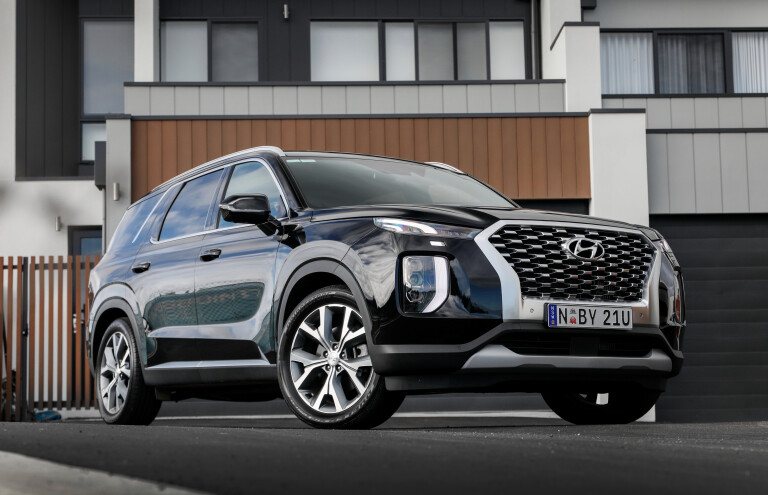
Meanwhile the Kluger is perhaps the least convincing of Toyota’s modern design language. Its ‘grumpy Stormtrooper’ nose lacks the assertiveness of the Palisade and the confident elegance of the CX-9. There’s some nice surfacing on the side that echoes the Supra and Yaris GR (we kid you not), but otherwise the Kluger is a fairly anonymous thing to look at.
It’s also the ‘smallest’ SUV here. The Palisade is larger than its Toyota rival, though only just. Sizing the two up with just your eyeballs would have you believe the Palisade has a markedly larger footprint, but it’s just a handful of centimetres that separate them in length, width and wheelbase. Astonishingly it’s the Mazda that’s the longest in this group, both in wheelbase and overall length, but venturing indoors reveals that running a tape measure across the exterior of these things means nothing when it comes to cabin utility.
Let’s start with the new kid. The Kluger’s first-row ergonomics are pretty good, with everything clearly labelled and falling within easy reach of the driver’s heated and cooled eight-way power adjustable seat. Forward vision is also great, with A-pillars that are remarkably slim for a modern SUV and a big head-up display to help keep your attention on the road ahead.
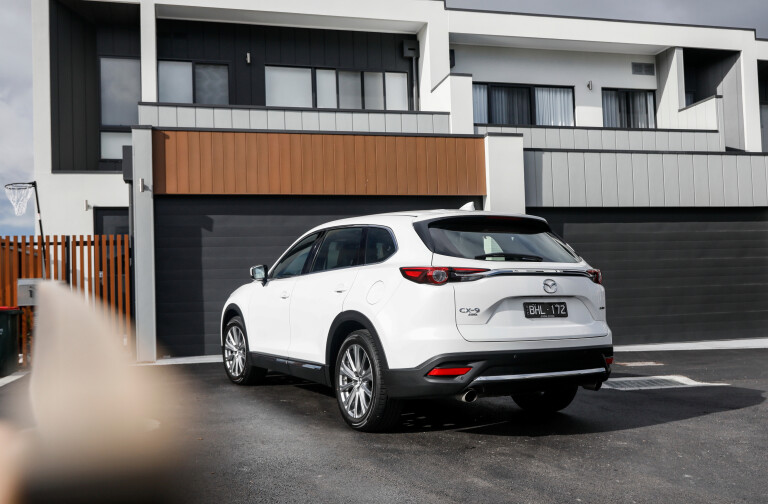
The 8.0-inch high-mounted screen and ventilation controls are easy to use with plenty of prominent buttons that are easily navigable by feel, but the infotainment software – and clumsy screen integration with the dash – leave much to be desired. Why should a car for the 2020s have in-car tech from the 2010s? At least Android Auto and Apple CarPlay are there to take out some of the sting, but Americans get a 12.3-inch touchscreen in their range-topper and we don’t. Unfair.
The intermediate shelf that runs across the dash is a handy bit of functional design, though, with grippy rubber to help contain whatever keys, wallets or phones you toss on there and a cable pass-through so you can keep your phone connected without leaving it on the cramped and slippery centre console tray. Given how mediocre the stock infotainment system is (and the fact that wireless smartphone mirroring isn’t available in the Kluger), you’ll want to keep your phone hooked up at all times.
The second row experience is solid, with a roomy three-seat bench, reclinable backrest and a good range of fore-aft adjustment on its slider. The Grande comes standard with a gigantic glass sunroof and it’s used to good effect, flooding the cabin with light and lifting the ambience considerably, while backseaters also have their own controls for the rear climate zone and roof vents pointing at each seat.

Things aren’t so rosy when it comes to the third row, however. For an adult, squeezing between the door frame and the middle seat isn’t an elegant operation, with the shape of the Kluger’s rear door aperture not big enough for easy third-row access – likely a side-effect of the Kluger having the shortest wheelbase in this group.
Once seated, you’ll find the Kluger’s third-row packaging is flawed for anyone larger than a small child. A knees-up posture, rock-hard cushions, tight headroom and a lack of USB outlets give the Kluger the worst third row in this gang – a surprising result given Toyota boosted third row seat width by 20mm and supposedly improved seat cushioning for this all-new Kluger.
Material quality is generally quite good, with plenty of soft-touch surfaces and decent leather upholstery, but the less said about the Kluger Grande’s overtly fake ‘woodgrain’ trim, the better.
Let’s hop into the Palisade. Hyundai’s largest SUV gets off to a strong start with some Benz vibes around its canted-back centre stack and monolithic instrument panel/infotainment screen integration, while the push-button transmission selector takes up less real estate and helps keep the centre console sleek and tidy.
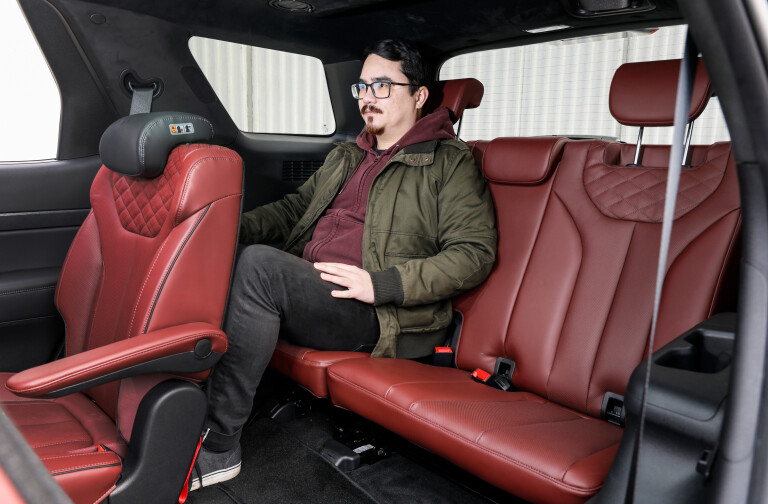
A retractable lid for the cupholder/phone charge pad recess allows clutter and valuables to be hidden away, as does the cavernous cubby beneath the centre armrest, while a capacious under-console shelf can easily accommodate a tissue box or handbag. Hyundai proves that merging functionality with good looks ain’t impossible.
The second row is where the Palisade really stands apart. Rather than the 2-3-2 seat layout of the other two, the Palisade gives the option of two separate captain’s chairs in the middle and a three-across bench in the back. Less practical than having a bigger bench in the centre row? Maybe if you need to fit more than three baby seats at a time, but here’s the thing: you can walk between those captain’s chairs, negating the need to fold them forward to gain access to the third row.
Not that folding them is particularly hard. While the Kluger and CX-9 use a traditional mechanical lever, the Palisade has an electronic button that releases both the backrest and the slider, and with the seat slid forward there’s plenty of room to step up into the rearmost seats. Its seventh seat is definitely the least useful given the narrower width of the third row, but the other six seats are hugely spacious – especially those in the second row, which are not only heated, but ventilated too.
There are also other thoughtful features throughout. USB charge ports on the front seat backrests keep cables from dragging on the floor, and there are a pair of USB ports and roof vents for the third row too.
What of the CX-9? Its cabin design is clean and timeless with elegant touches like backlit door pulls at night, but next to the button-heavy Palisade and Kluger it might look too minimalist for some. To our eyes it still looks great, and the Azami’s soft leather upholstery adds significant tactile appeal as well. Its tombstone style infotainment screen sits nice and high, and the CX-9’s remote controller makes it the only one in this group that doesn’t require you to put finger smudges on its screen.
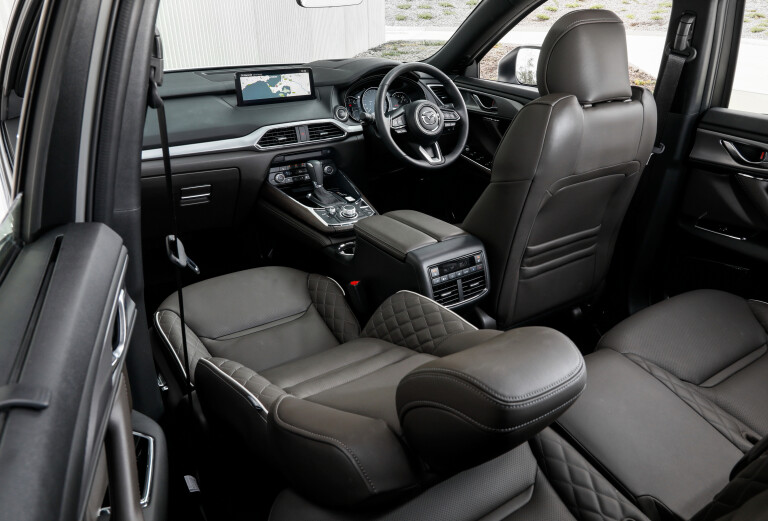
It could learn a lesson or two from the Palisade and Kluger about cabin storage though, with only a shallow tray ahead of the gear selector (which also houses a wireless phone charger) and a fairly modest centre console box in addition to the usual glovebox and door bins. The hard plastics around the cupholders also detract from what is otherwise a very sophisticated and classy cabin ambience.
Second and third row accommodation is middle-of-the-pack. The third row suffers a little in headroom thanks to the CX-9’s hatchback-like roofline and the absence of air vents back there, but seat comfort and entry/egress is nevertheless better than the Kluger.
When I drove the previous-gen Kluger at its national media launch, my one lasting memory of the event was my co-driver becoming quite seasick during a twistier section of the drive loop. I don’t blame him. That car had all of the pitch and roll of a tugboat in a tsunami. Credit to the engineers of the new Kluger, then, because its significantly improved body control and more improved damper calibration dramatically reduce the amount of head toss.
That said, it’s still a soft marshmallow compared to the firmer jellybeans that are the CX-9 and Palisade. All of them roll on 20-inch alloys with similar sidewall heights, but the Kluger skews more strongly toward comfort than the other two. In a way, that’s a good thing – these are family vehicles after all, and your partner, kids and Labrador care nought for how many lateral G you can sustain in a corner.
But that’s not to say that the CX-9 and Palisade are roller skates by comparison. The CX-9’s well-judged balance between ride and handling is as good as it’s ever been, with only a slightly sharp bump response from the 20-inchers and a fair bit of road noise taking the shine off its superb steering and big-hatchback dynamics.
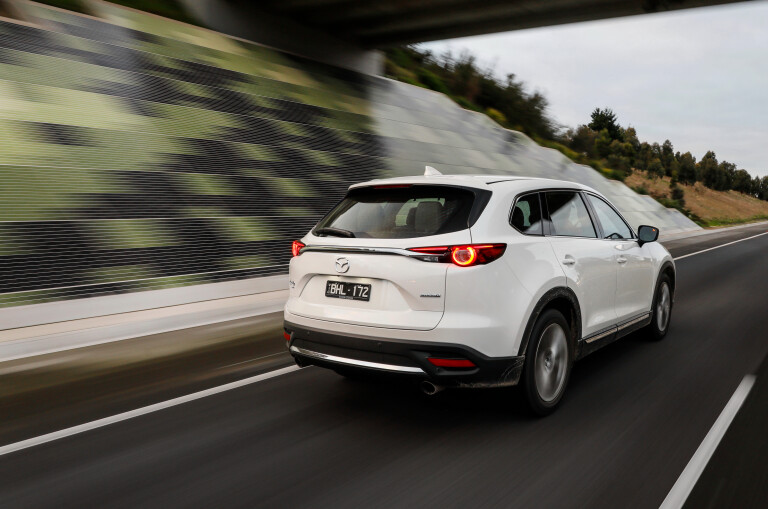
The Palisade sits somewhere in between. It’s firmer than you’d expect and quite sensitive to small-amplitude bumps, but glides easily over bigger stuff. Its mass is more obvious than the CX-9 when you ask it to change direction, but it feels more composed and willing to turn than the relatively mushy Kluger.
Shame about that noisy diesel – even at idle, it’s louder than we’d want for a family hack – but at least it’s got bags of torque and that slick-shifting eight-speed auto.
The Kluger’s mushiness extends to its powertrain. It excels in the light-throttle regime, being pedaled around sedately in stop-’n’-go traffic or in a steady highway cruise, where the switchover from petrol to electric is nearly imperceptible and the overall experience is best described as “serene”.
However, stomp the pedal flat and a coarse engine note and lethargic 8.4-second 0-100km/h sprint are the result. These are all big ol’ buses, but the Kluger, weighing in at 2090kg when empty, feels like a double-decker.
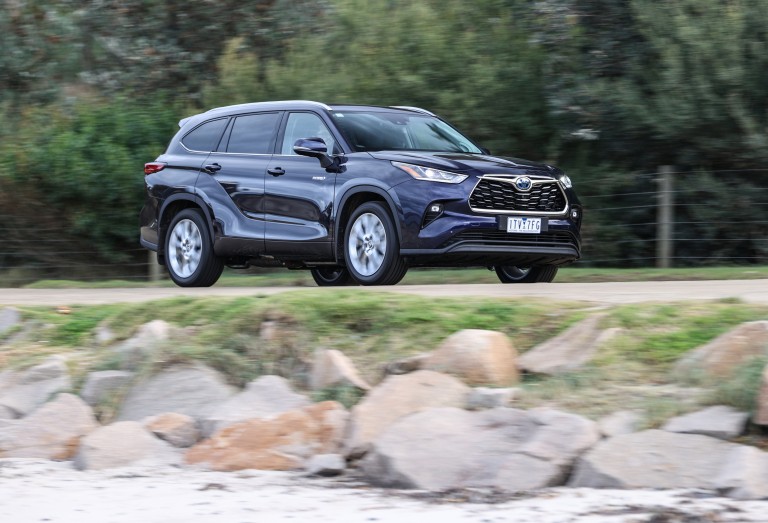
Its 6.5Ah high-voltage battery won’t sustain much electric-only driving too, and Toyota’s hybrid system will quickly flick on the combustion engine if you don’t use a feathertouch on the pedal – even if you thumb the ‘EV mode’ button beforehand.
It’s a chore to try and keep it within the electric-only parameters, but here’s the thing: without even trying to hypermile, we saw a 5.9L/100km average over our 100km test loop.
That’s easily better than the 7.4L figure we got from the diesel Palisade, and a full 4.0 litres less than the CX-9’s 9.9L/100km result over the same loop.
The CX-9’s 2.5-litre turbo might be a torque-laden delight with great power, response and a surprisingly sporty induction note, but you pay for those things at the petrol pump.
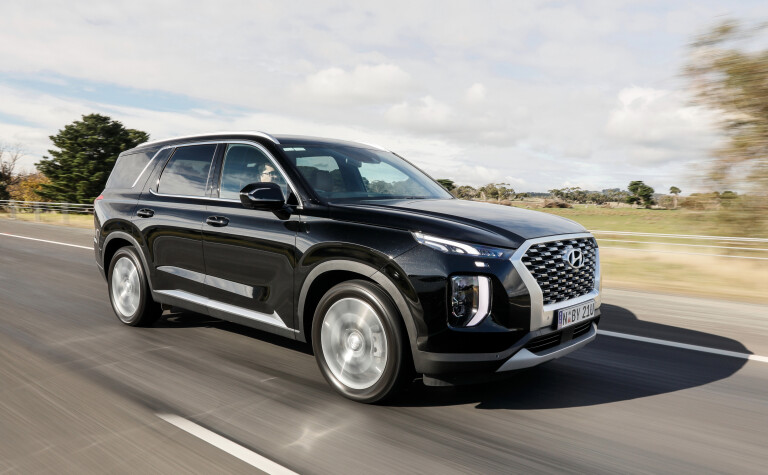
VERDICT
So, to the final crunch. For its family-friendly cabin, lengthy equipment list and balance between comfort, performance and fuel economy, the Palisade is the winner of this one.
Remember how I said value for money was important? Well, the Palisade gives you an eight-course banquet for a three-course price tag.
It’s full of intelligent features and practical packaging, and it seems like Hyundai involved more families in its focus groups than Toyota or Mazda. As far as fitness for purpose is concerned, the Palisade hits the bullseye.
Coming up behind it is the Kluger. Let down by a poorly executed third row and antique infotainment software, the rest of the Kluger package is actually quite good. Its hybrid option and softer nature will no doubt entice many, and with a potential fuel saving of 510-561 litres per year relative to a V6 Kluger Grande AWD (assuming you commute the national yearly average of 17,000km), it could be well worth the $2500 premium.
In fact, that fuel thriftiness is a big reason why the Kluger comes in second rather than third: fuel economy is a vital consideration for average Aussie families, even those with $75K to spend on their next car.
One might think that the Mazda slots into third, but the bronze medal remains in its case for today. Rather, the CX-9 Azami surprised us with its ability to remain fresh and relevant with a well-equipped and spacious cabin, strong performance and supremely car-like dynamics.
The CX-9 is the connoisseur’s choice, in our opinion, and a car that just feels right every time you slide behind its wheel. It doesn’t hurt that it’s also the most affordable one in this test, so it deserves to share second place.
SCORES
1. Hyundai Palisade: 8.5/10
2. Toyota Kluger: 8.0/10
2. Mazda CX-9: 8.0/10

| Model | Hyundai Palisade Highlander | Kluger Grande hybrid | Mazda CX-9 Azami |
|---|---|---|---|
| Price | $75,000 as-tested | $76,075 as-tested | $71,036 as-tested |
| Drivetrain | |||
| Engine | 4cyl, dohc, 16v, turbo | 4cyl, dohc, 16v, + triple electric motor | 4cyl, dohc, 16v, turbo |
| Layout | front engine (east-west) AWD | front engine (east-west) AWD | front engine (east-west) AWD |
| Capacity | 2199cc | 2487cc | 2488cc |
| Power | 147kW @ 3800rpm | 184kW (combined petrol/electric) | 170kW @ 5000rpm |
| Torque | 440Nm @ 1750-2750rpm | 242Nm @ 4400rpm (comb petrol/electric) | 420Nm @ 2000rpm |
| Gearbox | 8-speed automatic | CVT | 6-speed automatic |
| Chassis | |||
| Body | steel, 5 doors, 7 seats | steel, 5 doors, 7 seats | steel, 5 doors, 7 seats |
| L/W/H/W–B | 4980/1975/1750/2900mm | 4966/1930/1755/2850mm | 5075/1969/1747/2930mm |
| Track (F/R) | 1708/1716mm | 1665/1660mm | 1663/1633mm |
| Weight | 2059kg | 2090kg | 2010kg |
| Boot | 7-seat: 311L, 4-seat: 704L | 7-seat: 241L, 5-seat:552L, 2-seat: 1150L | 7-seat: 230L, 5-seat: 810L (to roof) |
| Fuel | diesel/71 litres | petrol 95RON/65 litres | petrol 91RON/72 litres |
| Economy | 7.4L/100km (tested) | 5.9L/100km (tested) | 9.9L/100km (tested) |
| Suspension | Front: struts, A-Arms, coil springs, anti-roll bar. Rear: multi-link , coil springs, anti-roll bar | Front: struts, A-Arms, coil springs, anti-roll bar. Rear: multi-link, coil springs, anti-roll bar | Front: struts, A-Arms, coil springs, anti-roll bar. Rear: multi-link, coil springs, anti-roll bar |
| Steering | electric power steering | electric power steering | electric power steering |
| Front brakes | ventilated discs (340mm) | ventilated discs (330mm) | ventilated discs (320mm) |
| Rear brakes | ventilated discs (314mm) | solid discs (315mm) | solid discs (325mm) |
| Tyre size | 245/50R20 Bridgestone Dueler HP Sport A/S | 235/55R20 Toyo Proxes C100 | 255/50R20 Falken Ziex CT50 A/S |
| Safety | |||
| ANCAP rating | Five stars | Five stars | Five stars |
| Performance | |||
| 0-100km/h | 9.5sec (estimated) | 8.4sec (claimed) | 7.7sec (tested) |

COMMENTS